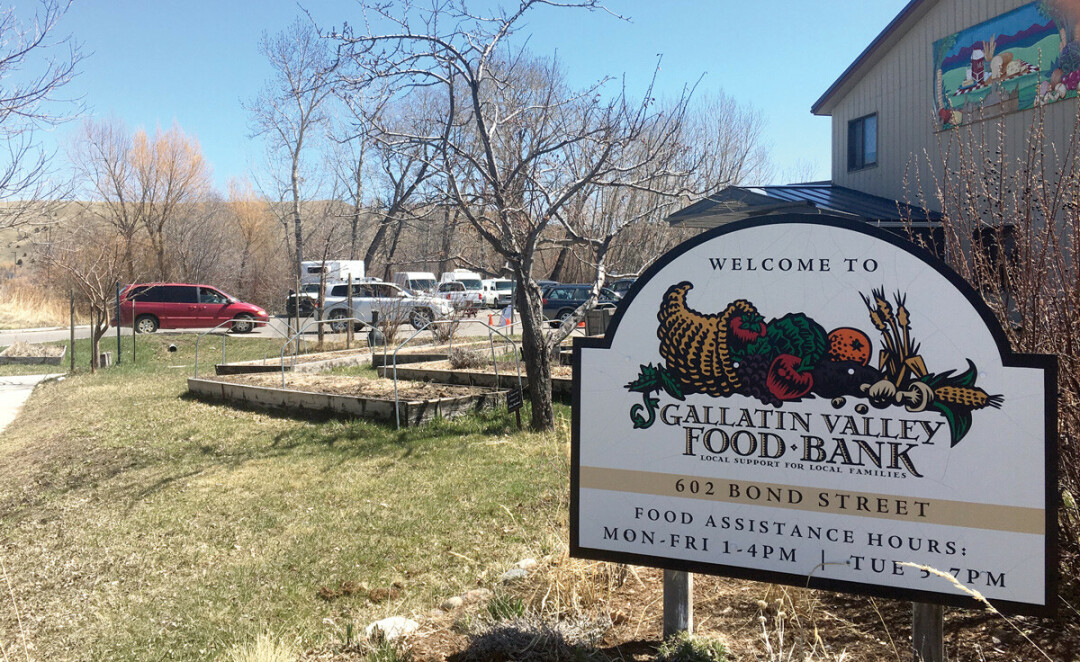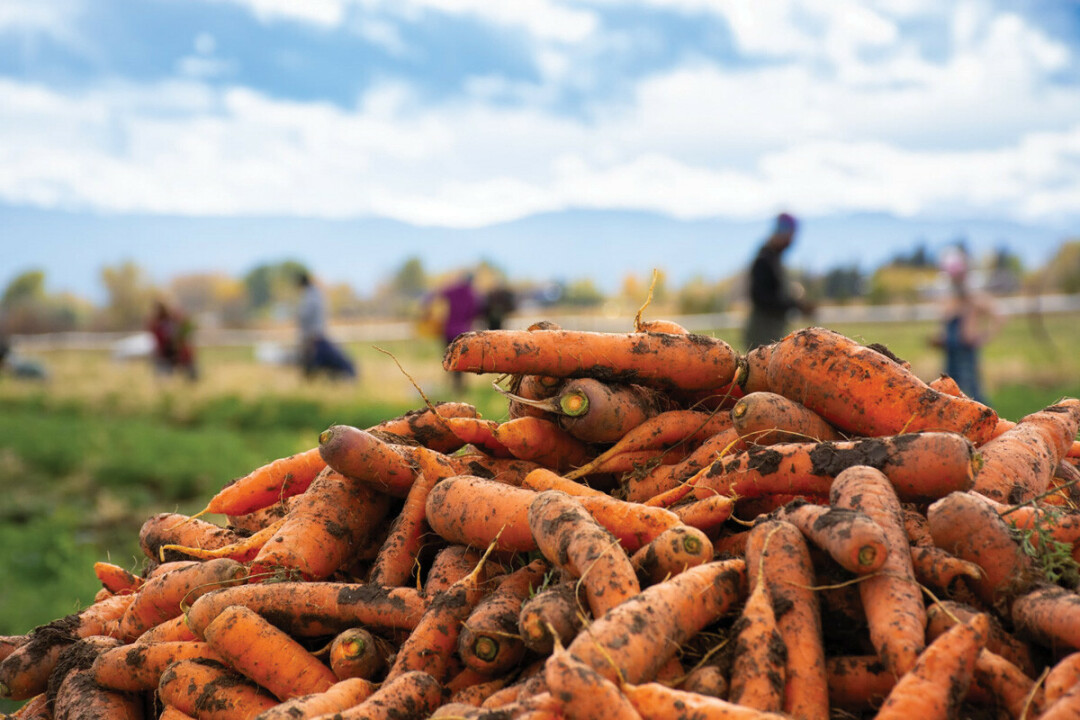Pandemic Creates Challenges in Distributing Food to Local Community
Heat-shimmering sedans, pickup trucks, and SUVs lined up behind one another in the sunny, spring afternoon, wrapping around an unassuming warehouse into the adjacent street: each waiting their turn to pull into the building’s modest parking lot. The occasional squeaking of fan belts and hum of idling engines softly traveled through the hazy air, and each vehicle steadily pumped out plumes of exhaust that shortly rose into the air before dissipating into translucence. Orange traffic cones corralled the cars along a loop, guiding them in towards the warehouse’s heavy freight doors before wrapping along the outside of its lot and leading them back around to the very street they arrived from.
Masked volunteers waved cars forward, tirelessly pulling the endless line along, and quickly bringing them various amounts of food in boxes, before sending them on their way. On the north side of the building, a long-abandoned lobby sat empty behind locked glass doors—various notifications and memos posted across its surface, explaining that because of the COVID-19 pandemic, the organization was currently operating through curbside pickup, rather than in-person shopping. A sign in front of the warehouse identified the business in bold font, reading, “Welcome to Gallatin Valley Food Bank,” listing its hours of operation below. This organization comprises one of five food and nutrition services of the Human Resource Development Council, a not-for-profit agency focusing on community action and operating across much of southwest Montana, Gallatin, Park, and Meagher County, and has been forced to cut down its manpower in order to maintain social distancing procedures since the onset of the COVID-19 pandemic in March of 2020.
This setting greeted me upon interviewing Jill Holder, HRDC’s Food & Nutrition Department Director, who works with the Gallatin Valley Food Bank, and illustrated the situation which the organization has been finding itself in as the COVID-19 pandemic forces it to take preventative safety measures. We sat across from each other in the facility’s deserted lobby, both muffled by surgical masks, and over-enunciating our words in order to understand each other over busy sounds of warehouse activity in the background—beeping forklifts, metallic clangs, and bustling volunteers hard at work.
Conversing with me, she explained the main problems that a global pandemic has presented to the organization—limitations for a customer to directly choose the food they want, and inabilities for the Gallatin Valley Food Bank to provide them with a personalized shopping experience.
“The biggest thing is, people aren’t able to shop themselves, so they’re not coming into the building and shopping in the grocery store. We’re basically building pre-packed food boxes, and then people are going through the drive-thru and picking them up. And so, there is no self-choice. [But] people can make requests, so if they’re a vegan or they have some sort of allergy then we’ll try to make the box work for them.”
However, COVID-19 hasn’t only been limiting the shopping choices of the food bank’s customers, it has also created logistical challenges in distributing fresh food items to them in a timely manner. Because they have been forced to cut down on volunteers to prevent the spread of COVID-19, less workforce exists in the space they have to help ship food out to the Gallatin Valley Food Bank’s curbside services. With fewer volunteers to help shoulder the workload, stockpiles of food are building up in storage, including perishable, fresh foods with fleeting expiration dates on the horizon.
With fresh food fast on its way to spoilage, and a former bastion of community aid cut down into a skeleton crew, COVID-19 has strained Gallatin Valley Food Bank’s workforce and storage capabilities, forcing them into a stalemate where they are ill-equipped to extend the longevity of fresh food requiring refrigeration. Holder commented on the limited capacity of the food bank, highlighting the organization’s need for more space.
While storage has always raised an issue for the organization to confront in the past, the minimization of staff allowed inside the facility to lend helping hands has not helped their situation. In a search for effective solutions, the organization has gone so far as to utilize whatever refrigeration units they can get their hands on to increase their refrigeration capacities. Holder expands on the steps which the Gallatin Valley Food Bank has taken to solve this conundrum, expanding on the challenges they have faced.
“The problems that existed with produce are the same problems we always have, which is storage. That’s why food banks, a lot of times, have lots of canned foods because they’re easy to store, where perishables take refrigerator space. For example, we actually have a refrigerator truck running three blocks away [from the GVFB]. That’s where we have fresh produce and some dairy and some meat right now.”
Though increasingly diminishing amounts of fresh food storage presents a very real problem, Holder points out that it is the customer’s lack of personal choice which seems to represent the biggest change COVID-19 precautions have developed. Ultimately however, in order to keep volunteers safe, staff cuts presented a challenging, yet necessary precaution. Even though the organization may have enjoyed adequate amounts of workers to satisfy the ever-growing demand for the food bank’s services in Bozeman before, now that it must responsibly avoid any potential infections, only a fraction of the crew can be utilized—highlighting desperate needs for more floor space to once again operate efficiently.
Staff cuts, coupled with more storage needed than ever before, does little to bode well for the organization’s future wellbeing. In further elaboration, Holder expanded on the unsettling idea that having less labor around to help with the large demand for Gallatin Valley Food Bank services negatively impacts the effectiveness of the food bank as a whole. She pointed out that volunteers simply can’t process the amount of fresh food that they need to in order to meet local demand.
“That [lack of personal choice] is the big difference with our [reaction to] COVID, that and the fact that we can’t bring in as much [produce], because we don’t have as much labor. Typically, we utilize hundreds of volunteers, and we, to try to reduce our risks, minimized that number of volunteers coming in.”
Gallatin Valley Food Bank also aims to conquer the unfortunate problem of limited floor space within its facility. While social distancing stands out as both an ethical and prudent course of action, maintaining six-foot distances from everyone inside their shopping area quickly becomes impossible. The facility simply does not possess enough square footage. In order to protect the food bank’s patrons, access into the facility remains regulated, and customers are not allowed inside. However, this regulation does little to help the organization’s internal productivity.
Matters quickly become even more complicated when considering how much demand actually exists for the organization in the community. In the past, things were simpler; an internal shopping area could easily meet a steady ebb and flow of customers going about their business within the facility and choosing the food they needed. Now, even bumping elbows with your neighbor could be hazardous for everyone’s health, and maintaining a safe distance from one another proves absolutely critical.
In the case of space, moving outside might be the food bank’s only viable short-term solution, and this is exactly what the Gallatin Valley Food Bank has done. Shifting the organization’s operations to facilitate an external, curbside drive-thru allows enough room for the same amount of people to benefit from food bank inventory, and Holder explains the reasoning behind the organization’s transition in servicing customers.
“This would be our lobby otherwise, and it’s pretty small, and sometimes we have as many as thirty people waiting to get in to shop and so that’s not going to work at all. Not to mention, the store space is very small and so we probably could have maybe five people shopping at once, and that moves them very, very slow which creates more and more contact, so this [drive-thru] was our answer.”
While moving customers outside may solve problems of liability, the Gallatin Valley Food Bank must also consider the wellbeing of the ones who help them deliver and process food. The people who work for the food bank and help it meet community demand are not immune to illness, and certainly not COVID-19. In fact, volunteers might actually face more risks of contracting the virus than many customers. While a customer may have opportunities to cut down on their exposure to others, volunteers may not have that privilege. In the mission of service, workers may face constant exposure to unknown individuals, one after another, with no prior knowledge of who they have been in contact with. It presents an ongoing high-stakes gamble—is this individual I am serving sick? Have we been in too close of contact? The potential for workers to suffer from seemingly unsolvable issues of exposure creates another unfortunate challenge the Gallatin Valley Food Bank must solve—demands for effective safety procedures create stark decreases in the efficiency of the food bank’s services.
With social distance practices regulating how many people can work to serve the Bozeman community inside the food bank, volunteers are finding themselves too pressed for space. In fact, the number of staff who can work in the facility at the same time has decreased dramatically, altering the amount of food which can be sent out—a process demanding more hands that can’t be there.
Holder states that procedures in place to reduce food bank volunteers results in a less effective workforce, even more so when considering that a substantial portion of the facility’s volunteers might be quite vulnerable to the virus. With few volunteers able to be accepted into the building, a constant workload has increased responsibilities.
“You just can’t move as much with less hands. A lot of our volunteers are seniors, so that kind of minimizes who’s coming in. But, we really did make the shift so we have three volunteers in the morning and four in the afternoon, but we could have up to ten in the morning and ten in the afternoon before the virus.”
Issues of distributing food with fewer working hands convolutes already-complicated logistical problems when learning that resources must be devoted, not just to having food stored away and distributing it, but often, also acquiring the food, sorting it, and processing it adequately to ensure it can be safely consumed. Because fair portions of fresh food the Gallatin Valley Food Bank procures originates from “food rescue,” the method of salvaging food from local businesses which would otherwise go to waste, more steps (and unfortunately more amounts of time) intertwine between the act of acquiring fresh food at a facility and processing what is received into portable units which are ready to give back to the public.
Holder expands on the complicated nature of sustaining a food rescue model, lamenting the fact that efficiently utilizing the method generally requires more workers than can currently be allowed in the facility. As good of a process that food rescue is, it may demand resources the food bank cannot provide, and in turn struggle to create the community support that the organization wishes to give.
“There is another step to that [processing food], in that a lot of the food comes from food rescue, and so we’re going out and we’re picking up foods, and bringing them back here, and then we have to sort through them before we can give them out. That takes multiple steps and multiple hands, so we’re doing less food rescue than we typically would.”
The intimidating struggles plaguing the Gallatin Valley Food Bank do not remain isolated to similar organizations in the Bozeman area. Nationwide, an increased demand caused by the COVID-19 pandemic has strained the resources that food banks provide, with organizations such as New York City’s Camba Inc. providing emergency food to 18,324 people in June 2020 (www.camba.org/programs/beyond-hunger-emergency-food-pantry/). Other organizations, such as the Los Angeles Regional Food Bank, have seen an increase of 70% in demand for their resources, with 26.9 million pounds of food having been distributed since March—a total of 1.2 million people having been served (https://www.lafoodbank.org/wp-content/uploads/Coronavirus-Status-Report_6.02.2020.pdf).
With so much happening around the nation, it is comforting to know that even with the seemingly unsolvable challenges it faces, as members of the Bozeman community, everyday citizens—our neighbors, peers, and friends—still have power to take actions and show support to the HDRC and other community-driven organizations similar to the Gallatin Valley Food Bank. Solutions do exist to eliminate the problems our local food donation services see developing; whether increasing the size of the Gallatin Valley Food Bank’s facility, working within the community to help decrease the level of demand for food bank services, or simply striving to support our neighbors and friends in whatever way we can.
However, the community struggles quickly rising in our own backyards cannot be solved unless we as individuals decide to help; without a fair bit of elbow grease and the will to act, nothing will be done, and nothing can change. If our local community collectively decides not to support local services that give aid to those in need, the question is not a matter of if these services will cease to exist, but instead, only a question of when.
In the chase for facilitating a solution of workload pressure that her organization has been experiencing, Holder gives advice for directions that anyone might take, in order to help lighten local demand for food bank resources. Among the most helpful, she argued, was the pursuit of community awareness to identify problems that create increased demand for Gallatin Valley Food Bank services, as well as a call-to-arms in supporting similar nonprofit organizations.
“If there was one message for everyone, I would say to invest in all of the nonprofits that you believe in. I think HDRC is a really important nonprofit, because we answer to the community’s needs, or community action agency, and so every three years we ask the question ‘What does this community need more than anything else?’ and then we program in that direction. And so, I feel like we are in the process of working on a new facility and I would ask that people would help with that.”
While the problems encountered by the Gallatin Valley Food Bank highlight problems for the organization’s productivity under the increasing presence of our national pandemic, the prospect of finding solutions which allow for the betterment of community service in Bozeman is heartening. Though faced with uncertain futures, with the cooperation of neighbors and friends in genuine Montana style, our community holds unique opportunities in times of crisis to band together, and make our community a better place.
If you would like to support the Gallatin Valley Food Bank, please visit its website at https://gallatinvalleyfoodbank.org/#donate, or visit the Human Resource Development Council of District IX Facebook page for up-to-date information on community events and opportunities.
